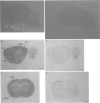Abstract
1. The binding of the first selective radiolabelled histamine H3-receptor antagonist [125I]-iodophenpropit to rat cerebral cortex membranes was characterized. 2. [125I]-iodophenpropit, radiolabelled to a high specific activity of 1900 Ci mmol-1, saturably bound to a single class of sites with a KD of 0.57 +/- 0.16 nM (n = 4) and Bmax of 268 +/- 119 fmol mg-1 protein. 3. Specific binding at a concentration below 1 nM represented 50 to 60% of total binding. 4. Binding of [125I]-iodophenpropit to rat cerebral cortex membranes was readily displaced by histamine H3-agonists and antagonists. In contrast, the inhibitory potencies of selective histamine H1- and H2-receptor ligands were very low. 5. [125I]-iodophenpropit was biphasically displaced by the histamine H3-receptor antagonists, burimamide and dimaprit, which may indicate the existence of histamine H3-receptor subtypes. Other histamine H3-receptor antagonists showed a monophasic displacement. 6. Competition binding curves of H3-agonists were biphasic and showed a rightward shift upon the addition of the nonhydrolysable GTP analogue, guanosine 5'-o-(3-thio) triphosphate (GTP gamma S; 100 microM) which implicates the interaction of histamine H3-receptors with G-proteins. The affinities of the H3-receptor antagonists iodophenpropit, thioperamide and burimamide were not altered by GTP gamma S. 7. Histamine competition binding curves were shifted to the right by different nucleotides (100 microM) with a rank order of potency GTP gamma S > Gpp(NH)p, GTP.(ABSTRACT TRUNCATED AT 250 WORDS)
Full text
PDF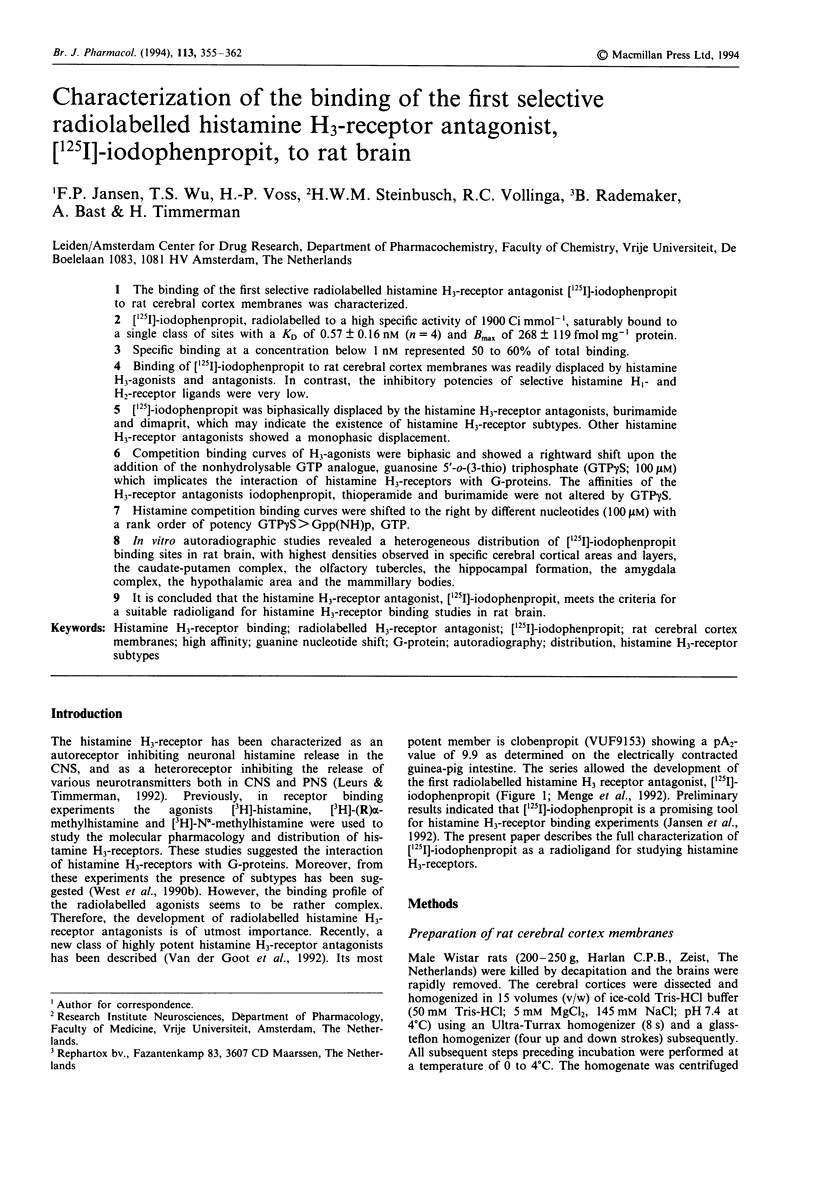
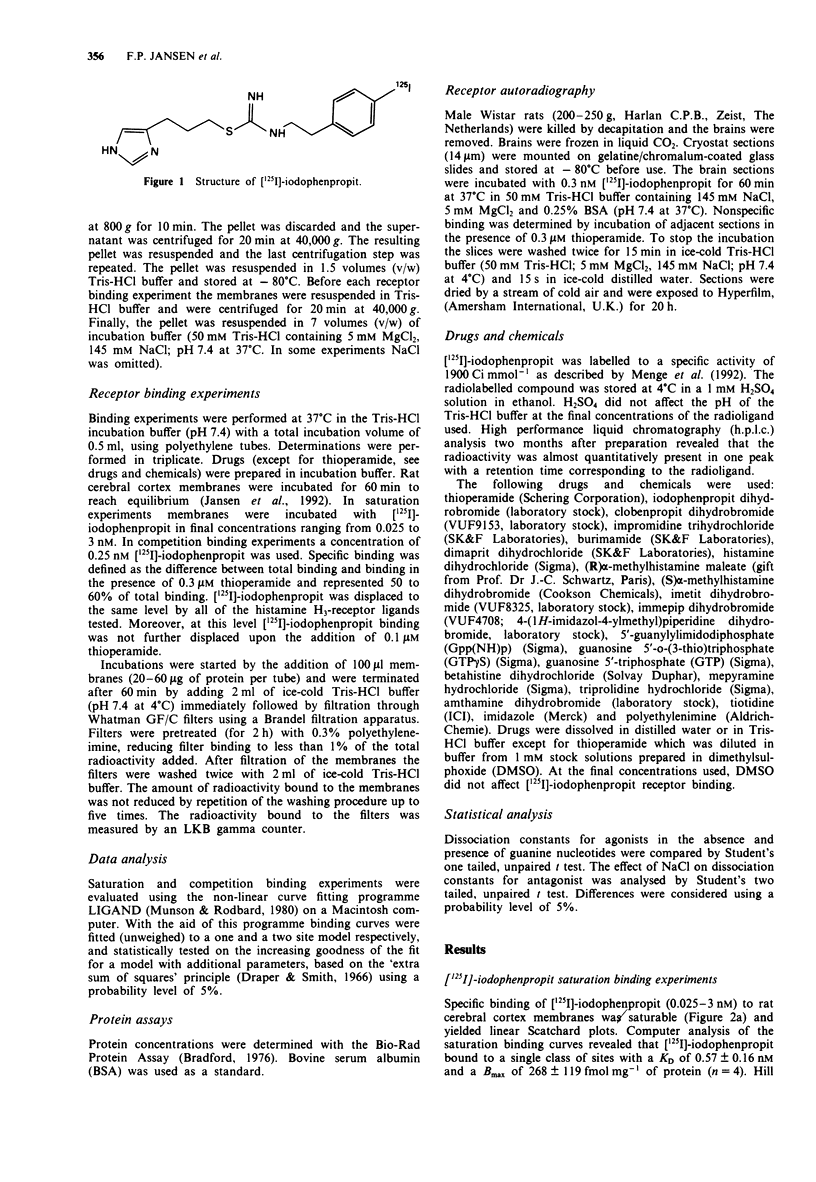

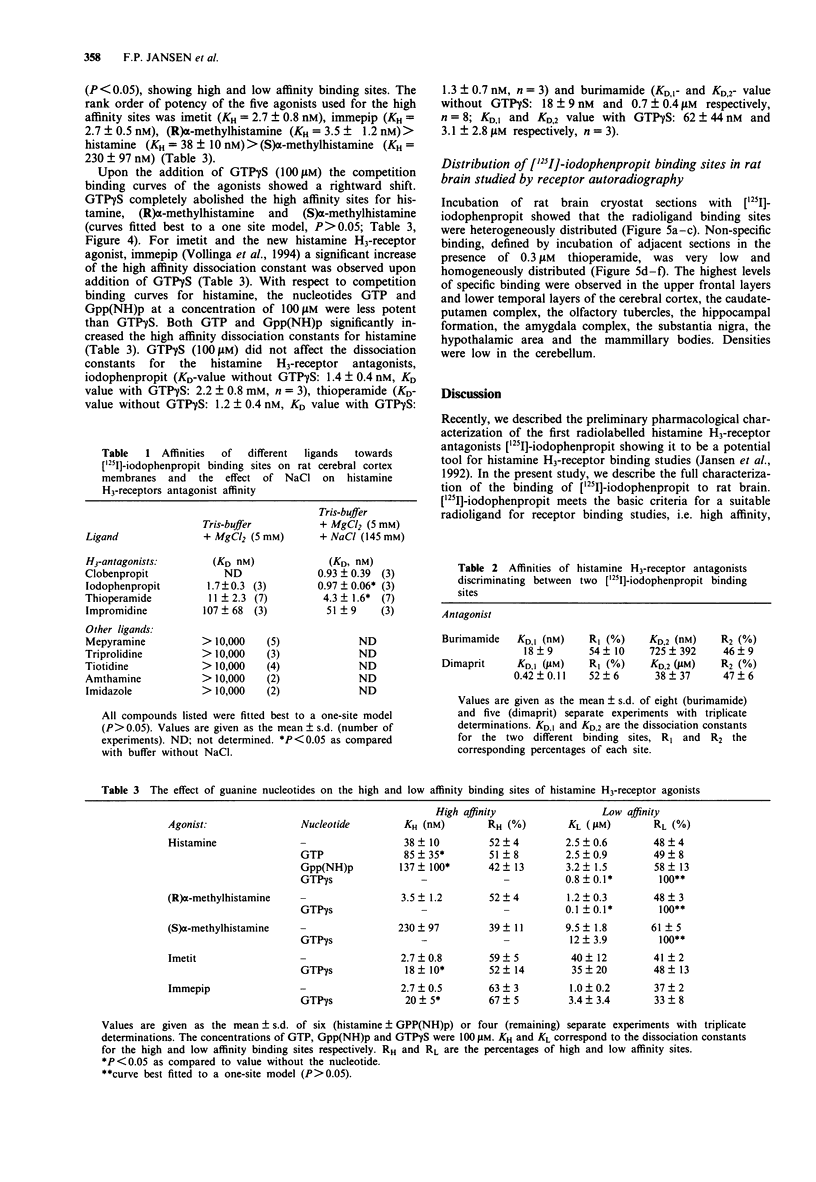
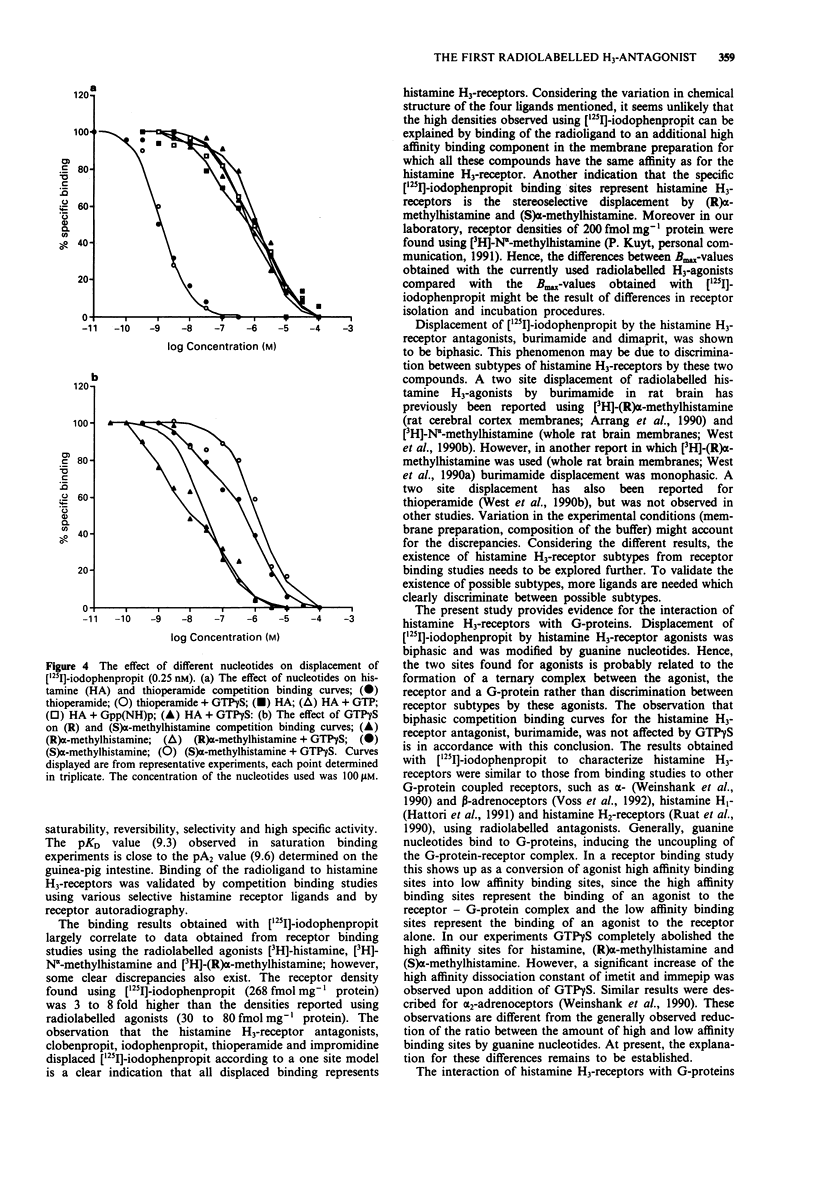
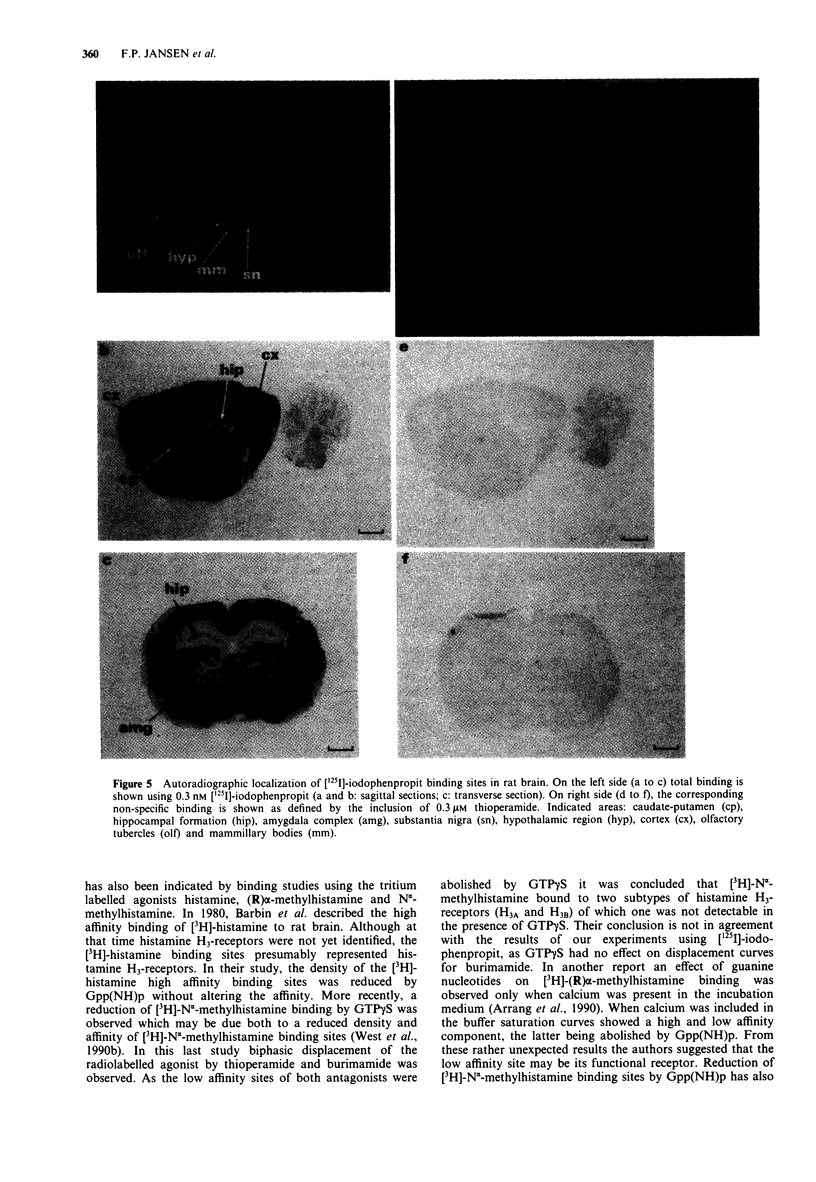
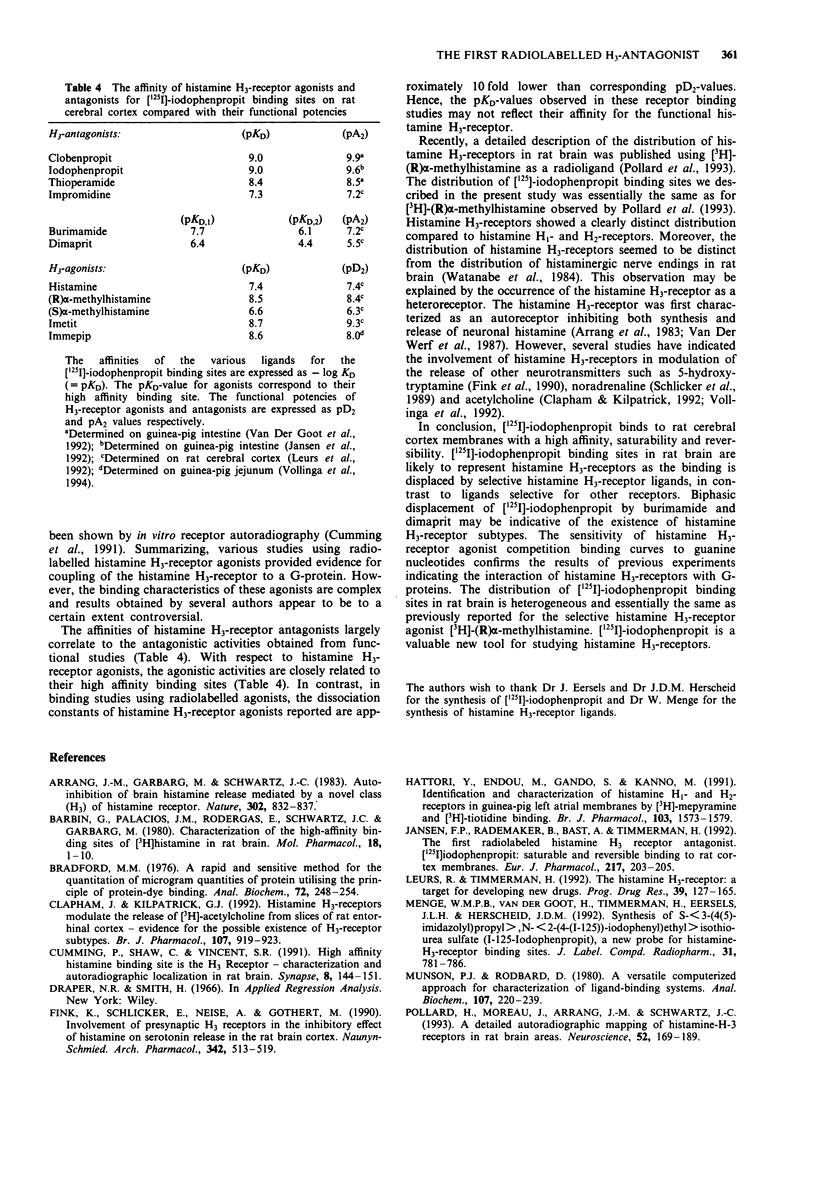
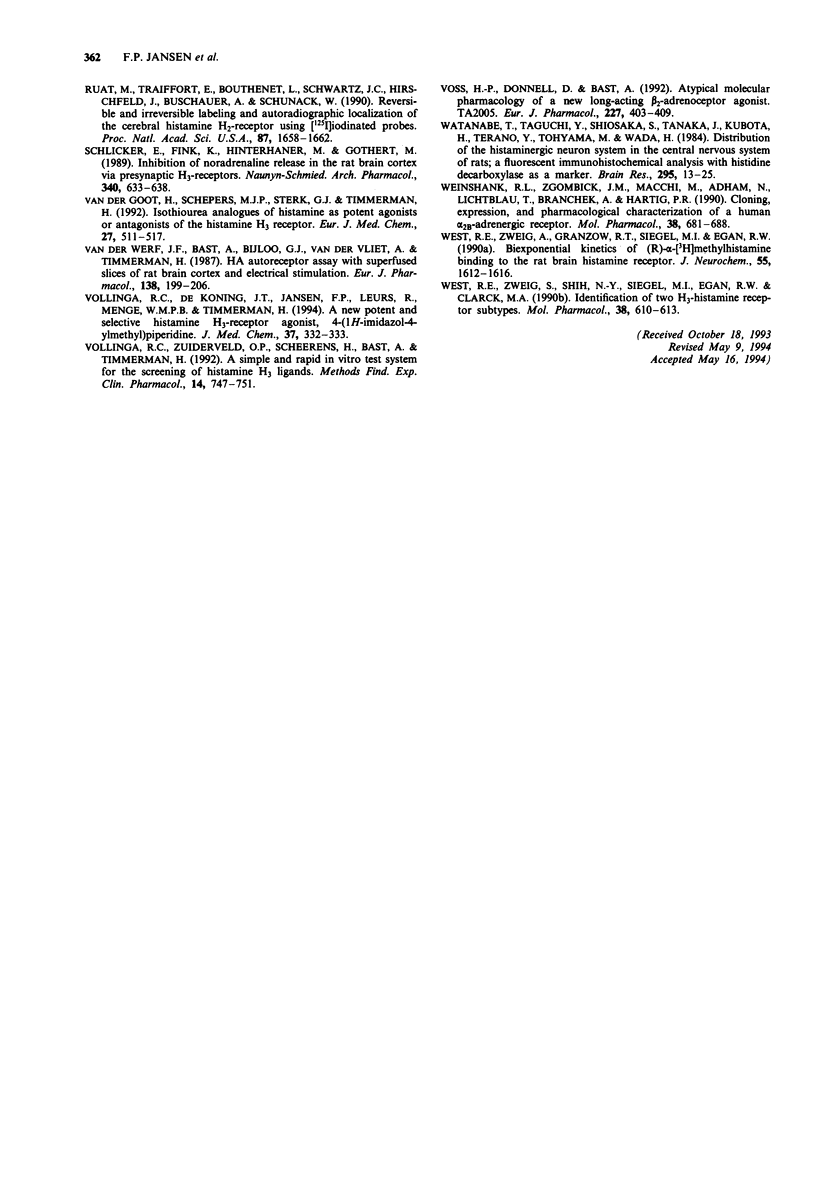
Images in this article
Selected References
These references are in PubMed. This may not be the complete list of references from this article.
- Arrang J. M., Garbarg M., Schwartz J. C. Auto-inhibition of brain histamine release mediated by a novel class (H3) of histamine receptor. Nature. 1983 Apr 28;302(5911):832–837. doi: 10.1038/302832a0. [DOI] [PubMed] [Google Scholar]
- Barbin G., Palacios J. M., Rodergas E., Schwartz J. C., Garbarg M. Characterization of the high-affinity binding sites of [3H]histamine in rat brain. Mol Pharmacol. 1980 Jul;18(1):1–10. [PubMed] [Google Scholar]
- Bradford M. M. A rapid and sensitive method for the quantitation of microgram quantities of protein utilizing the principle of protein-dye binding. Anal Biochem. 1976 May 7;72:248–254. doi: 10.1006/abio.1976.9999. [DOI] [PubMed] [Google Scholar]
- Clapham J., Kilpatrick G. J. Histamine H3 receptors modulate the release of [3H]-acetylcholine from slices of rat entorhinal cortex: evidence for the possible existence of H3 receptor subtypes. Br J Pharmacol. 1992 Dec;107(4):919–923. doi: 10.1111/j.1476-5381.1992.tb13386.x. [DOI] [PMC free article] [PubMed] [Google Scholar]
- Cumming P., Shaw C., Vincent S. R. High affinity histamine binding site is the H3 receptor: characterization and autoradiographic localization in rat brain. Synapse. 1991 Jun;8(2):144–151. doi: 10.1002/syn.890080208. [DOI] [PubMed] [Google Scholar]
- Fink K., Schlicker E., Neise A., Göthert M. Involvement of presynaptic H3 receptors in the inhibitory effect of histamine on serotonin release in the rat brain cortex. Naunyn Schmiedebergs Arch Pharmacol. 1990 Nov;342(5):513–519. doi: 10.1007/BF00169038. [DOI] [PubMed] [Google Scholar]
- Hattori Y., Endou M., Gando S., Kanno M. Identification and characterization of histamine H1- and H2-receptors in guinea-pig left atrial membranes by [3H]-mepyramine and [3H]-tiotidine binding. Br J Pharmacol. 1991 Jun;103(2):1573–1579. doi: 10.1111/j.1476-5381.1991.tb09829.x. [DOI] [PMC free article] [PubMed] [Google Scholar]
- Jansen F. P., Rademaker B., Bast A., Timmerman H. The first radiolabeled histamine H3 receptor antagonist, [125I]iodophenpropit: saturable and reversible binding to rat cortex membranes. Eur J Pharmacol. 1992 Jul 7;217(2-3):203–205. doi: 10.1016/0014-2999(92)90851-t. [DOI] [PubMed] [Google Scholar]
- Leurs R., Timmerman H. The histamine H3-receptor: a target for developing new drugs. Prog Drug Res. 1992;39:127–165. doi: 10.1007/978-3-0348-7144-0_4. [DOI] [PubMed] [Google Scholar]
- Munson P. J., Rodbard D. Ligand: a versatile computerized approach for characterization of ligand-binding systems. Anal Biochem. 1980 Sep 1;107(1):220–239. doi: 10.1016/0003-2697(80)90515-1. [DOI] [PubMed] [Google Scholar]
- Pollard H., Moreau J., Arrang J. M., Schwartz J. C. A detailed autoradiographic mapping of histamine H3 receptors in rat brain areas. Neuroscience. 1993 Jan;52(1):169–189. doi: 10.1016/0306-4522(93)90191-h. [DOI] [PubMed] [Google Scholar]
- Ruat M., Traiffort E., Bouthenet M. L., Schwartz J. C., Hirschfeld J., Buschauer A., Schunack W. Reversible and irreversible labeling and autoradiographic localization of the cerebral histamine H2 receptor using [125I]iodinated probes. Proc Natl Acad Sci U S A. 1990 Mar;87(5):1658–1662. doi: 10.1073/pnas.87.5.1658. [DOI] [PMC free article] [PubMed] [Google Scholar]
- Schlicker E., Fink K., Hinterthaner M., Göthert M. Inhibition of noradrenaline release in the rat brain cortex via presynaptic H3 receptors. Naunyn Schmiedebergs Arch Pharmacol. 1989 Dec;340(6):633–638. doi: 10.1007/BF00717738. [DOI] [PubMed] [Google Scholar]
- Van der Werf J. F., Bast A., Bijloo G. J., Van der Vliet A., Timmerman H. HA autoreceptor assay with superfused slices of rat brain cortex and electrical stimulation. Eur J Pharmacol. 1987 Jun 19;138(2):199–206. doi: 10.1016/0014-2999(87)90433-x. [DOI] [PubMed] [Google Scholar]
- Vollinga R. C., Zuiderveld O. P., Scheerens H., Bast A., Timmerman H. A simple and rapid in vitro test system for the screening of histamine H3 ligands. Methods Find Exp Clin Pharmacol. 1992 Dec;14(10):747–751. [PubMed] [Google Scholar]
- Vollinga R. C., de Koning J. P., Jansen F. P., Leurs R., Menge W. M., Timmerman H. A new potent and selective histamine H3 receptor agonist, 4-(1H-imidazol-4-ylmethyl)piperidine. J Med Chem. 1994 Feb 4;37(3):332–333. doi: 10.1021/jm00029a002. [DOI] [PubMed] [Google Scholar]
- Voss H. P., Donnell D., Bast A. Atypical molecular pharmacology of a new long-acting beta 2-adrenoceptor agonist, TA 2005. Eur J Pharmacol. 1992 Dec 1;227(4):403–409. doi: 10.1016/0922-4106(92)90158-r. [DOI] [PubMed] [Google Scholar]
- Watanabe T., Taguchi Y., Shiosaka S., Tanaka J., Kubota H., Terano Y., Tohyama M., Wada H. Distribution of the histaminergic neuron system in the central nervous system of rats; a fluorescent immunohistochemical analysis with histidine decarboxylase as a marker. Brain Res. 1984 Mar 12;295(1):13–25. doi: 10.1016/0006-8993(84)90811-4. [DOI] [PubMed] [Google Scholar]
- Weinshank R. L., Zgombick J. M., Macchi M., Adham N., Lichtblau H., Branchek T. A., Hartig P. R. Cloning, expression, and pharmacological characterization of a human alpha 2B-adrenergic receptor. Mol Pharmacol. 1990 Nov;38(5):681–688. [PubMed] [Google Scholar]
- West R. E., Jr, Zweig A., Granzow R. T., Siegel M. I., Egan R. W. Biexponential kinetics of (R)-alpha-[3H]methylhistamine binding to the rat brain H3 histamine receptor. J Neurochem. 1990 Nov;55(5):1612–1616. doi: 10.1111/j.1471-4159.1990.tb04946.x. [DOI] [PubMed] [Google Scholar]
- West R. E., Jr, Zweig A., Shih N. Y., Siegel M. I., Egan R. W., Clark M. A. Identification of two H3-histamine receptor subtypes. Mol Pharmacol. 1990 Nov;38(5):610–613. [PubMed] [Google Scholar]



